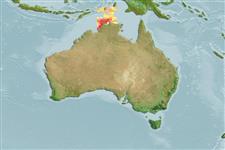>
Clupeiformes (Herrings) >
Engraulidae (Anchovies) > Engraulinae
Etymology: Stolephorus: Greek, stole, -es = garment + Greek, pherein = to carry (Ref. 45335).
Environment: milieu / climate zone / profondeur / distribution range
Écologie
marin pelagic-neritic; profondeur 0 - 50 m (Ref. 189). Tropical; 7°S - 14°S, 128°E - 135°E (Ref. 189)
Western Central Pacific: known from a single specimen from Saulte Point, Coburg Peninsula, Northern Territory, Australia.
Taille / Poids / Âge
Maturité: Lm ? range ? - ? cm
Max length : 7.2 cm SL mâle / non sexé; (Ref. 189)
Épines dorsales (Total) : 0; Épines anales: 0; Rayons mous anaux: 16. With 7 small needle-like pre-pelvic scutes. Maxilla tip pointed, reaching only just to front border of pre-operculum; hind border of pre-operculum convex, rounded. Isthmus muscle tapering evenly forward to hind border of branchial membrane. Pelvic fin tips presumably not reaching to below dorsal fin origin. No dark pigment lines on back between head and dorsal fin.
Body shape (shape guide): elongated; Cross section: compressed.
Presumably coastal, pelagic and schooling, but more material and data needed. Egg presumed to be oval with a knob (as in S. indicus).
Life cycle and mating behavior
Maturité | Reproduction | Frai | Œufs | Fécondité | Larves
Whitehead, P.J.P., G.J. Nelson and T. Wongratana, 1988. FAO Species Catalogue. Vol. 7. Clupeoid fishes of the world (Suborder Clupeoidei). An annotated and illustrated catalogue of the herrings, sardines, pilchards, sprats, shads, anchovies and wolf-herrings. FAO Fish. Synop. 125(7/2):305-579. Rome: FAO. (Ref. 189)
Statut dans la liste rouge de l'IUCN (Ref. 130435: Version 2025-1)
Menace pour l'homme
Harmless
Utilisations par l'homme
Pêcheries: commercial
Outils
Articles particuliers
Télécharger en XML
Sources Internet
Estimates based on models
Preferred temperature (Réf.
123201): 28 - 28.8, mean 28.3 °C (based on 46 cells).
Phylogenetic diversity index (Réf.
82804): PD
50 = 0.5000 [Uniqueness, from 0.5 = low to 2.0 = high].
Bayesian length-weight: a=0.00501 (0.00220 - 0.01140), b=3.14 (2.96 - 3.32), in cm total length, based on LWR estimates for this Genus-body shape (Ref.
93245).
Niveau trophique (Réf.
69278): 3.3 ±0.4 se; based on size and trophs of closest relatives
Résilience (Réf.
120179): Haut, temps minimum de doublement de population inférieur à 15 mois (Preliminary K or Fecundity.).
Fishing Vulnerability (Ref.
59153): Low vulnerability (10 of 100).
🛈
